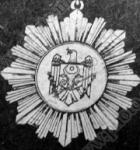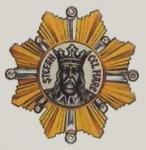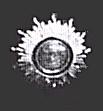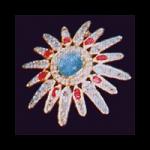
James Hoard
For Deletion-
Posts
632 -
Joined
-
Last visited
-
Days Won
1
Content Type
Profiles
Forums
Blogs
Gallery
Events
Store
Everything posted by James Hoard
-
Many thanks IVB, that would be most useful. This decoration seems to have a surprisingly high precedence to the type of award you describe. Any particular reason for this? Cheers, James
-
Many thanks for the corrections. I am afraid things got a little mixed up when my first attempt at posting had the word "Recunostinta", using the correct and original characters. Everything seemed to go wrong and I went into panic mode. Lines bled into each other, images would not load, and all sorts of things happened. I tried to reduce the images, change text style, spacing, ac. Nohing worked until I finally figured out what was causing it all. I was the "s" tail. By the way what is the correct translation of "Recunostinta"? Cheers, James
-
Hello, Many thanks for your kind input. Of course you are quite right. Perhaps it is best to call the republic "Moldova" instead of Moldavia? Thanks also for the link and for the additional posts. Much appreciated. Cheers, James
-
-
-
-
I have not seen very much on the Orders and Decorations of Moldavia, so here is my small contribution on this little known republic. Apologies for the quality of the pictures, but most of them come from a set of stamps issued about 1999. Ordinul Republicii (or the Order of the Republic) ? founded on 30th July 1992 (Legii nr.1123-XII) as a general award for exceptional meritorious services to the state and in all areas of human endeavour. Ordinul Stefan cel Mare (or the Order of Stephen the Great) ? founded on 30th July 1992 (Legii nr.1123-XII) as the highest military decoration of the republic for supreme acts of valour and self sacrifice during military operations, maintaining public order or security. Ordinul de Onoare (or the Order of Honour) ? founded on 27th September 2002 and awarded for meritorious services to national consolidation, promotion of democracy, reformation and peace. Ordinul Gloria Muncii (or the Order of Labour Glory) ? founded on 30th July 1992 (Legii nr.1123-XII) and awarded for exceptional meritorious service in one's area of work or endeavour leading to success in that area of activity or expertise, especially in the scientific and technical fields. Ordinul Credinta Patriei (or the Order of Service to the Fatherland) ? founded on 30th July 1992 (Legii nr.1123-XII) and modified on 28th July 2004 (Legii nr.292-XV). Awarded in three classes for services in the security field, the armed forces, frontier corps, interior troops and the forces that maintain law and order. Class I is limited to 15 appointments per annum, Class II to 10, and Class III to 5. Ordinul Recunostinta Patrei (or the Order of the ? (Restoration?) of the Fatherland) ? founded on 30th July 1992 and awarded in a single class for meritorious services in the filed of education and science. Medalia Meritul Militar (or Military Medal of Merit) ? founded on 30th July 1992 (Legii nr.1123-XII) and awarded for heroism or courageous service in war for the maintenance of national independence, defence of the sovereignty of the republic, etc. Medalia Pentru Vitejie (or Bravery Medal) ? founded on 30th July 1992 (Legii nr.1123-XII) and awarded for courageous acts of humanity, the maintenance of public order, combating crime, etc. Medalia Meritul Civic (or Civic Medal of Merit) ? founded on 30th July 1992 (Legii nr.1123-XII) and awarded for meritorious civic merit in the performance of duty. Medalia Mihai Eminescu (or Mihai Eminescu Medal) ? founded on 30th July 1992 (Legii nr.1123-XII) and awarded for merit in the creative fields, especially in literature and the arts. Medalia Nicolae Testemitanu (or the Nicolae Testemitanu) ? founded on 30th July 1992 and awarded for merit in the fields of public health and sanitation. Medalii Jubilare (or Jubilee Medal) ? awarded to commemorate the 60th anniversary of liberation from Facism. Any additions, corrections or illustrations are welcome. Cheers, James Hoard
-
Yes, "not so dear foot", your second sentence makes that abundantly obvious.
-
Portugal - Order of Christ, breast star
James Hoard replied to saschaw's topic in Southern European & Balkan States
Saschaw, I am also not an expert but from what I do no know, both types of star were found concurrently. Your type tends to be of Portuguese (Costa) manufacture for the period 1862-1910. The other type from the catalogue tends to be either a) foreign manufacture or b) Portuguese manufacture when awarded/encrusted with diamonds or brilliants. For the ordinary stars, both classes look the same but Grand Cross is usually gold or silver-gilt, Commander is silver. I am not 100% sure when your "cut, pierced and irregular circumferance" type of breast star came in but think that it is towards the late nineteenth century rather than 1862 itself. Cheers, James -
Megen, Surely, these are two of the most politically incorrect decorations there ever could be. Cheers, James
-
Kevin, We have not reached the end of the world yet, so we have no more idea of what the "end result" is than we know what the full casualty statistics for the current conflicts in Iraq and Afghanistan are. Whether the brass recommended blue on blue awards or not is neither here nor there. The clamour for such awards will arise in exactly the same way as the proposal for the medal in the first place. The press will create a stir if they try and deny it to those killed in the next such American attack on British troops. Incidentally, the UK proposal has not actually specified who exactly will and who will not receive the medal. Cheers, James
-
Hello Hugh, It opened for me but the pictures posted on the site took a very long time to load. Perhaps this may have caused a "time out" with your programme. Are you using Explorer 6 or above? Cheers, James
-
Ah what a pity, I used to know an old gentleman who served with them, but is alas no more. Some years ago, I was in Jerusalem on business, visiting the Chief Rabbi's organisation about an important Kosher certification of one of our plants. After the meeting, my exhausted colleagues and I sat down for coffee at a nearby caf?. I was musing to them, a little too loudly, about the oddity of there still being a thoroughfare called "King George V". Given that the Jewish state was not exactly enamoured with the Brits, and in most other former colonial outposts, such names were usually ditched. There was something of a murmur from the table behind us. A distinguished old gent, with a crisp clipped moustache, tapped me on the shoulder and said "Young man. Why should we not have a street named after His Majesty? He was our King too". We then sat down and had a long natter about his interesting life. He had been a lieutenant-colonel in the Jewish Brigade and ended the War with the OBE. Of this he was very proud, because he had been personally invested by the late King George VI. I think I grew-up by several years after that first conversation. Cheers, James
-
Kevin, The figures I quoted are from the detailed study conducted for the US Department of Defence after the First Gulf War. I quoted the First Gulf War because, as far as I know, that conflict is over. If I was quoting from the present Gulf War or Afghanistan, obviously I would have said so. As for soldiers calling for this and calling for that, the whole idea of a wound medal did not come from soldiers in the first place. It arose out of a newspaper campaign, subsequently taken up by politicians who then told the top brass to look into it. Cheers, James
-
Paul, The website has been moved to a new location at http://www.royalark.net/index.html As for the comments by Ed, Chris has an awful lot more information than McClenaghan's book. In some cases like the awards of Tripura, Hyderabad and Sachin, Tony has either guesswork or hardly any information. Cheers, James
-
I just came across this message only now, but the attribution may well be correct. Here is a small scan (courtecy of Christopher Buyers) from a book by Rudolph Said-Reute, the son of the samous Princess Salme. He received the First Class of he Saidi Order and there is a portrait photograph of him in the book. This small scan was taken from there. Not sure of the exact title, but it could be "Said bin Sultan" (1929).
-
-
-
-
-
It appears that the decorations that I posted earlier may actually be "title badges" of sorts, rather than actual orders. There is a website of sorts at http://rajasurakarta.com/darjah.html However, the site seems to be written in Malaysian Bahasa by some sort of Malaysian group of recipeints. He high number of Malaysian and Chinese names would suggest that I may belong to the "gong hunting fraternity". There seem to be a lot of titles being used that have been "Malaysianised", and which would be unknown in Java. There is also a clear absence of understanding of Javanese forms and derivations. For example, "Haryo" and "Arya" are exactly the same. The former is the old transliteration for Romanised characters via Dutch pronunciation forms, the latter the modern Indonesian Bahasa. On the website, the oddly appear as two separate titles! Anyway, here is some information on a few genuine Surakara orders, decorations and medals that may be of interest. 1. Orders Bintang Kanjeng Kiai Suryawasesa: probably founded by Susuhanan Prabhu Sri Paku Buwana X as the highest ranking and most exclusive decoration of his realms. An eighteen-rayed bejewelled star, nine of which are long with nine shorter rays between them, no spaces between. Bintang Kasenapaten: probably founded by Susuhanan Prabhu Sri Paku Buwana V in the middle of the nineteenth century. A sixteen-rayed bejewelled gold star, eight rays long and eight rays short, with spaces between the long and short rays. In the centre, a large and naturally cut polished saphire surrounded by a wide band of diamonds. Each of the eight short rays embellished with a red carbunckle at the base, towards the centre. Bintang Kumpeni (the Order of the Company): founded by Susuhanan Prabhu Sri Paku Buwana IV to celebrate the alliance between Surakarta and the VOC. An eight-pointed star with ball-finials at the tips of each point. The points are straight but shallow, the inner "V" not extending very far inwards. A central round medallion containing a letter, similar to a stylised "eight" possibly the VOC symbol, and surrounded by a tight band of jewels. An outer band of large and small individual jewels half-way between the central medallion and the inner "V" of the star points. Bintang Daendels (the Order of the Company): founded by Susuhanan Prabhu Sri Paku Buwana IV and named after Marshal H.W. Daendels, Governor-General of the Indies during the French occupation. An eight-pointed star in cut-silver, of shallow, rounded points, plain and without finials. An outer circular band of tightly encrusted jewels at the base of the "V" points of the star; within, four square gems: north, south, east and west; four round gems between the square ones. An inner circular medallion also with a stylised letter within. The above orders seem to be extremely rare, probably only conferred on royalty. The following two awards are conferred relatively more widely. They have continued to be awarded since 1948 and about five or six are still conferred every year. 2. Decorations Bintang Sri Kabadya: instituted by Susuhanan Prabhu Sri Paku Buwana X in 1893. Awarded in three classes (1. First Class or Bintang Sri Kabadya Tingat I, 2. Second Class or Bintang Sri Kabadya Tingat II, and 3. Medali Sri Kabadya Third Class or Tingat III). Bintang Sri Nugraha (The Star of Honour): instituted by Susuhanan Prabhu Sri Paku Buwana X 16th September 1904. Apparently insituted in substitution for the award of the Pujung Sri Nugraha (Umbrella of Honour) to two Dutch citizens on 3rd February 1903 after the Dutch authorities objected to the "insult" of such a native award to Dutch subjects. Awarded in three classes (1. First Class or Bintang Sri Nugraha Tingat I, 2. Second Class or Bintang Sri Nugraha Tingat II, and 3. Third Class or Medali Sri Nugraha Tingat III). 3. Medals. Paku Buwana X Silver Jubilee Medal: instituted by Susuhanan Prabhu Sri Paku Buwana X to commemorate the 25th anniversary of his accession to the throne on 3rd January 1929. Awarded in two classes (1. First Class in gilt, and 2. Second Class in silver). Inscribed - Tanggal 12 Ramelan Tahun JE, 1822-1862 and 29-11-1866 ? 3-1-1929 (CE). Paku Buwana X 40th Anniversary Medal: instituted by Susuhanan Prabhu Sri Paku Buwana X to commemorate the fortieth anniversary of his accession to the throne on 21st January 1932. Awarded in two classes (1. First Class in gilt, and 2. Second Class in silver). This medal sometimes turns up amongst Dutch military groups. Gusti Raden Ayu Sekar Kedaton Medal: instituted by Susuhanan Prabhu Sri Paku Buwana X to commemorate the sixteenth birthday and the marriage of his most senior ranking daughter, Princess Kuswinayah, on 2nd October 1934. Awarded in two classes (1. First Class in gilt, and 2. Second Class in silver). Inscribed - Gusti Raden Ayu Sekar Kedaton Kuswinayah tumbuk yuswo 16 tahun, Selasa Wage tanggal 22 Jumadi al-akhir tahun wawu 1849-1865 (JE) and 28-9-1919 ? 2-10-1934 (or 1936) (CE)". Apparently, there was also a rather fine medal in silver that in appearance has a bus similar to that on the Paku Buwana X Silver Jubilee Medal, but was encrusted with diamonds or precious stones. Conferred on King Leopold III of Belgium when he visited Java in 1935. Cheers, James Hoard Bintang Kasenapaten
-
Kevin, Well, if it is the wounding that is to be recognised why are wounds received in "blue on blue" actions not to be recognised? As for frequency of incidents, it all depends on what one regards as "not enough". I would suggest a good hard look at the actual statistics. In the First Gulf War the UK lost 24 casualties killed, of whom 9 were killed by American attacks. That is 37.5% of deaths. The US's own statistics for their own forces were 24%. Comparable figures for conflicts from the Great War until 1991 averaged at about 15%. Of course, given the sensitivity of the issue, one suspects that the real figures an incidents are played down and attempts made to find every other possible reason to record, to avoid the "blue on blue" label. So the real figure is likely to be actually higher. Why the problem seems to be getting worse is difficult to understand. Despite the supposed system of identification for allied forces, extra training, and so on, problems persist. One still has reports from British soldiers that they are being misidentified by the American, even though they have been waving huge union jacks and yelling out that they are British. Cheers, James
-
Kev, If awards for 'blue on blue' injuries are not going to be made, the effect is going to be obvious to anyone who meets a soldier with injuries. Those with an injury and wearing a medal = enemy action. Those sporting wounds and no medal = blue on blue. One has to ask oneself, is the purpose of the award to recognise the injury undergone or to recognise who was doing the shooting? Cheers, James













